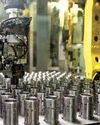OVER THE PAST SIX months, the Indian rupee has appreciated by nearly seven per cent against the US dollar. According to conventional wisdom, exports should have fallen. In recent months, the opposite has happened. Exports had begun sliding from 2015 when the rupee was around 66-67 to the US dollar. Today, with the rupee having strengthened to 63-64 a dollar, exports have, against conventional wisdom, picked up.

Obviously macro-economic factors have played an important part in India’s poor export performance over the past three years. But it’s clear that a strong rupee is not necessarily an impediment to higher exports nor is a weak rupee a guarantee for higher exports. Apart from the state of the global economy, oil prices and macro-economic indicators, domestic productivity plays a large part in boosting export growth.
A strong rupee has several advantages. First, it moderates inflation. Second, it lowers the cost of imports. For a country with a large trade deficit, running at over $150 billion (Rs 9.60 lakh crore) annually, a strong rupee is a boon, not a bane. Oil prices are climbing upwards of $70 a barrel. Gold has stabilised at over Rs 30,000 for 10 gms. These two commodities form the bulk of India’s import bill. The country imports 82 per cent of its crude oil. Gold remains a major attraction for households as a hedge against inflation.
India’s trade deficit is unlikely to dip soon. The government’s push to switch to electric cars and buses by 2030 will help reduce India’s dependence on oil imports in the long term. But as British economist John Maynard Keynes said, in the long term we are all dead.
The right level of currencies has lately become a contentious issue globally. US President Donald Trump has been accused of “talking down” the dollar, saying it will help US trade. The head of the powerful European Central Bank (ECB), Mario Draghi, said recently: “When someone says that a good exchange rate is good for exporters and good for the economy, that means (he is) targeting the exchange rate.”
This story is from the {{IssueName}} edition of {{MagazineName}}.
Start your 7-day Magzter GOLD free trial to access thousands of curated premium stories, and 9,000+ magazines and newspapers.
Already a subscriber ? Sign In
This story is from the {{IssueName}} edition of {{MagazineName}}.
Start your 7-day Magzter GOLD free trial to access thousands of curated premium stories, and 9,000+ magazines and newspapers.
Already a subscriber? Sign In

MEMORIES & IMPRESSIONS
Ratan Tata was an exceptional human being. He was a visionary leader, esteemed industrialist, and a humanitarian, who left an indelible mark on India and the world.

The Robotaxi Market
The robotaxi market is shaping up to be a high-stakes battleground as tech giants and automakers race to transform urban mobility.

And the Nobel Prize Goes to AI
The recent Nobel Prize T awards to AI pioneers affiliated with Google have sparked a broader conversation about Big Tech's influence on research and the limitations of traditional prize categories.

Ola Electrified
Once considered a trailblazer in India’s electric vehicle (EV) ecosystem, Bhavish Aggarwal’s Ola Electric now faces a major accountability crisis.

Sharp Slide in Industrial Output on Eve of Deepavali
India’s index of industrial production (IIP) saw a sharp reversal in August, contracting by 0.1 per cent, in stark contrast to the 4.7 per cent growth in July, mostly because of significant contractions in mining and electricity generation.

Heralding the Solar Era with Sustainable Electrification
RAJEEV KASHYAP on the economics of solar power, the hurdles in scaling it, and much more

A WELL-GREASED MACHINE
The OmniBook X14 laptop runs on first-generation Snapdragon X Elite, which bets big on Al-enabled productivity and battery life, but falls short when it comes to overall experience, says Deep Majumdar

DO NOT LETA HEALTH CRISIS RUIN YOUR FINANCIAL HEALTH
For a family of four living in a metro, it is recommended to opt for a family floater health insurance plan with a sum insured of at least Rs 15-20 lakh

Disruption Ahead: Beyond Organisation Charts and Structures
ALBERT EINSTEIN FAMOUSLY said, “We cannot solve our problems with the same thinking we used when we created them.

Dr. Rahul Shivajirao Kadam: A Visionary Leader Blending Sustainability, Innovation, And Social Empowerment
We are on the stage of global warming, and these technologies not only help prevent further damage but also leave behind a better environment for future generations.